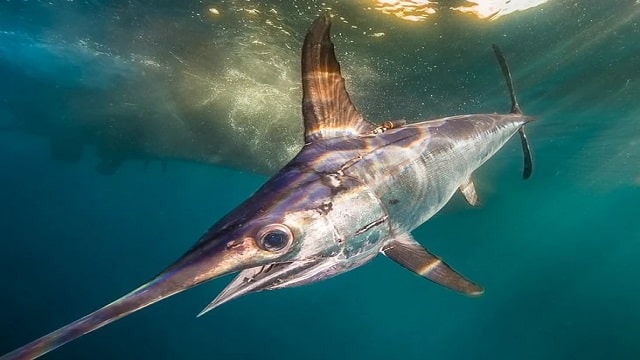Emperor fish and swordfish are not the same type of fish. They live in different habitats, they taste different, and the ideal way to prepare them differs from one to the other. Below are all the differences and how to get the most out of them in the kitchen.
Fish is an excellent source of protein and healthy fat that we can cook in hundreds of ways: grilled, baked, steamed, fried, in a stew or even in a pie. There are countless fish recipes and the only thing we need to worry about is knowing the type we have in our hands. Today, we’ll tell you all about the difference between emperor fish and swordfish.
What is the emperor fish?
The emperor fish ( Luvarus imperialis) is a fish from the Luvaridae family, order Perciforme, which inhabits tropical and subtropical waters. It is difficult to find it in markets and fishmongers since it lives around 200 m deep, far from the usual fishing areas. Even so, when we find it, its cut is so similar to that of the swordfish that it is common to confuse one for the other. It is different when we talk about the morphology of the whole piece. The emperor fish stands out for its pinkish hue, measures around 1.50 m, and weighs about 150 kg. Its meat is considered blue fish due to its content of more than 20% in healthy fats. Unfortunately, it is in the fats where mercury accumulates, so, if you have access to its consumption, it is not recommended to include it more than once a week in your menu.
What is swordfish
The swordfish ( Xiphias gladius) is a fish that belongs to the family of xiphids, of the order Perciforme, like the emperor fish. The back of the swordfish is dark blue, its belly is silver and it has an elongated snout that has earned it the nickname “swordfish” or “needle palate”. The swordfish lives in the Adriatic Sea, the Mediterranean Sea, the Black Sea and the Atlantic Ocean, usually found in the open sea and near the coast, in summer. The swordfish is a large fish that can reach 6 meters in length and 500 kg in weight, although the average is 2 meters and 100 kg. It feeds on other blue fish such as mackerel and also enjoys cephalopods and squid. It is a healthy source of protein although it easily accumulates mercury, so, as with the emperor fish, it is best not to consume it more than once a week.
Swordfish and emperor fish: how to tell them apart?
Because there is a lot of confusion between swordfish and emperor fish, it is important to know what makes them different. Below, we review the characteristics that will allow us to easily recognize them and cook them in the most appropriate way.
Its shape is very different, especially the mouth.
Swordfish and emperor fish are very different morphologically. Swordfish are dark blue in colour, with a silver belly, and can reach 6 m in length and weigh up to half a ton. The emperor fish, on the other hand, is characterised by its pinkish reflections, and although it is also a large fish, it does not usually exceed 2 m in length and 100 kg in weight.
The most indisputable feature that differentiates them is their mouths. The emperor fish has a slightly flattened face and a small mouth, while the swordfish has an elongated snout like a sword, which it also uses as such.
Their habitat is different
On the other hand, the swordfish is a fast fish that lives in the open sea, it feels comfortable at depths of less than 200 metres and is a great hunter of squid and other blue fish. The emperor fish, on the other hand, prefers to live in epipelagic depths, beyond 200 m, in tropical and subtropical regions of the world, and although it likes to eat jellyfish, its diet also includes zooplankton.
The emperor contains more calcium, but less selenium
Emperor fish and swordfish are rich in healthy fats and minerals. Both types of fish provide up to 22% of the recommended daily amount of omega-3 and between 3 and 5% of iron and zinc. Regarding selenium, swordfish has a higher content: 80% compared to 60% in emperor fish. The opposite occurs with calcium: emperor fish contains 3% calcium compared to 1% in swordfish, and both types of fish provide around 1% of vitamin A.
In any case, both are an indisputable source of protein, with a contribution of 19.5 g per 100 g of fish and thanks to their mineral content, both emperor fish and swordfish are ideal for maintaining strong skin, hair, and nails, maintaining a strong immune system and reducing free radicals.
Swordfish have a firmer texture and more intense flavor.
Due to the different lifestyle of the swordfish compared to the emperor fish, its meat is different. Swordfish, fast, hunter, and very active, has firmer meat and a more intense flavor. It is ideal for grilling, baking or frying with only pepper and lemon juice.
On the other hand, the emperor fish has creamier flesh and a milder flavour, so it is best reserved for steamed preparations and complemented with delicate sauces that round out the bite without camouflaging the flavour.
